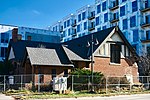Iowa City, Iowa

Iowa City is the county seat and largest city of Johnson County, Iowa, United States. It is the home of the University of Iowa and county seat of Johnson County, at the center of the Iowa City Metropolitan Statistical Area. At the time of the 2020 census the population was 74,828, making it the state's fifth-most populous city. The metropolitan area, which encompasses Johnson and Washington counties, has a population of over 171,000. The Iowa City Metropolitan Statistical Area (MSA) is also a part of a Combined Statistical Area (CSA) with the Cedar Rapids MSA. This CSA plus two additional counties are known as the Iowa City-Cedar Rapids region which collectively has a population of nearly 500,000. Iowa City was the second capital of the Iowa Territory and the first capital city of the State of Iowa. The Old Capitol building is a National Historic Landmark in the center of the University of Iowa campus. The University of Iowa Art Museum and Plum Grove, the home of the first governor of Iowa, are also tourist attractions. In 2008, Forbes magazine named Iowa City the second-best small metropolitan area for doing business in the United States.
Excerpt from the Wikipedia article Iowa City, Iowa (License: CC BY-SA 3.0, Authors, Images).Iowa City, Iowa
East Washington Street, Iowa City
Geographical coordinates (GPS) Address Nearby Places Show on map
Geographical coordinates (GPS)
| Latitude | Longitude |
|---|---|
| N 41.66 ° | E -91.53 ° |
Address
Iowa City Police Department
East Washington Street 410
52240 Iowa City
Iowa, United States
Open on Google Maps








